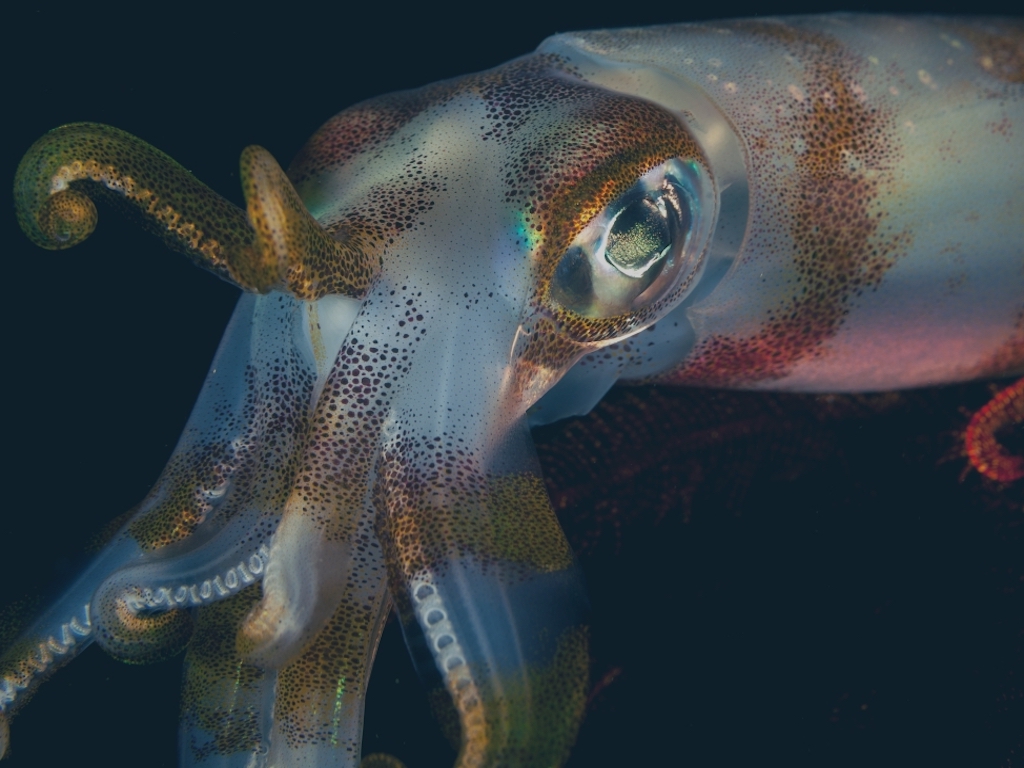12 Mins Read
This article is republished with permission from OceansAsia, a Hong Kong-based nonprofit organisation dedicated to ocean conservation and exposing wildlife crimes and activities that are polluting our marine ecosystems.
By: OceansAsia
The BIG Issue
Over the past few weeks social media has erupted over a large Chinese squid fleet operating near the Galapagos Islands along the border of their EEZ (Exclusive Economic Zone) and next to the Galapagos National Park, a UNESCO World Heritage site. The arrival of this fleet has become a seasonal event for the past four years.
The Galapagos is not the only location where we see squid boats en-masse. Off the coast of Argentina in the South Atlantic and in the waters near North Korea, fleets with their bright lights are well known to airline pilots who often think they are flying above cities rather than open ocean. And squid fleets can even be seen from space.
There has been a lot of conflicting information regarding this fleet, its composition and its intended catch, and the legality of its action. Headlines scream that the fleet is fishing for sharks and that “they just pull up everything,” but something seems a little fishy with this reporting. Moving beyond the headlines, we have noticed a worrying reliance on inaccurate information and geopolitical issues muddying the waters, obscuring serious conservation issues.
Our goal with this post is to shed light on what appears to be going on with the large Chinese fishing fleet off the coast of the Galapagos, and to highlight the conservation issues involved.
From available automatic identification system (AIS) data, it is very clear that the fleet is intentionally operating in international waters, where the legality of its actions depends on the species it is targeting (and methods it employs). In this case, the vessels appear to be targeting squid, which would make their activities legal, as the region has a squid fishery regulated by the South Pacific Regional Fishery Management Organization (SPRFMO). China is a member of the SPRFMO, which has a host of regulations including vessel registration and transshipment reporting.
So what’s going on?
The Reporting
The reporting on this fleet has been hyperbolic and worryingly inaccurate. A Bloomberg headline screams “Chinese Shark-Fishing Fleet Off Ecuador’s Coast Fuels Superpower Tension,” and fails to make a single mention of squid. And recent Daily Mail article under the headline “China’s 300-mile fishing fleet which is visible from SPACE and hoovers up all sea life is decimating endangered species – and plastic waste thrown overboard is polluting the shores of Darwin’s Galapagos Islands, scientists warn” claims that “ostensibly fishing squid, the real target for the 265-strong fleet are sharks to serve the appetite for expensive fin soup, costing up to £350 a bowl, sold in markets across China and Hong Kong.” It goes on, claiming that “night and day, the vessels – many the size of a football pitch – ransack the seabed, scooping up not only whale and hammerhead sharks but other species including turtles and birds.” The article then includes an image of a squid jigging moored next to a reefer, ostensibly transshipping squid.
A significant number of stories draw connections with the case of the ‘Fu Yuan Yu Leng 999’ and use images of this vessels shark-filled holds (see for example source; source; source; source; source). This vessel was apprehended by Ecuadorian authorities in 2017 after sailing through the Galapagos National Park with 300 tons of sharks in its hold. This vessel had previously transshipped shark from four Chinese long-liners operating to North West of the Galapagos. While this is relevant background information about a serious and prominent example of illegal fishing around the Galapagos, the vessel in question was intercepted 1,100 km north of the location and the case concerned sharks.
Stuff, a New Zealand media outlet reported “Chinese vessels off Galapagos ‘cloaking’ in New Zealand,” drawing New Zealand into the story. This article reported that the AIS data of six of the vessels were “transmitting false information via their Automatic Identification System transponders, which make them appear to be fishing in New Zealand waters.” Diving deeper into the story, however, we find that five of the six vessels were legitimately fishing for squid with authorisation from SPRFMO. The article then quotes the New Zealand Ministry of Primary Industries Director of Compliance Gary Orr who noted that “we are aware of the positions that these vessels have exhibited, but we are not aware of any verified information which would suggest this is being offset intentionally to misreport their true positions.”
The reality is that we know that sharks are being illegally caught in the waters around the Galapagos, and that this activity that has a devastating effect on marine wildlife and ecosystems has been going on for a longtime (see for example source; source; source). For example, in May, 2020, 26 tons of illegal shark fins were seized by authorities in Hong Kong. The fins, which included CITES protected thresher and silky sharks were labeled as ‘dried fish’ and came from Ecuador. Some of these cases involve Chinese vessels like the ‘Fu Yuan Yu Leng 999,’ while other involved Ecuadorian long-liners and vessels flying a host of other flags.
Illegal fishing is happening on the high seas by fleets of all nations, and with the largest fishing fleet in the world, Chinese vessels are certainly contributing their share and engaging in IUU fishing around the world. Furthermore, sharks are being caught illegally in the waters of Galapagos and across the planet, and this is having a devastating effect on shark populations and marine ecosystems. But, is the Chinese squid fishing fleet currently off the coast of Galapagos engaged in illegal shark fishing as some news outlets breathlessly suggest?
To determine this, we need to focus on the solid facts and evidence, as opposed to guesswork and assumptions.
So what are the facts? Below are our findings and facts, read them and make up your own mind. Then take action…..
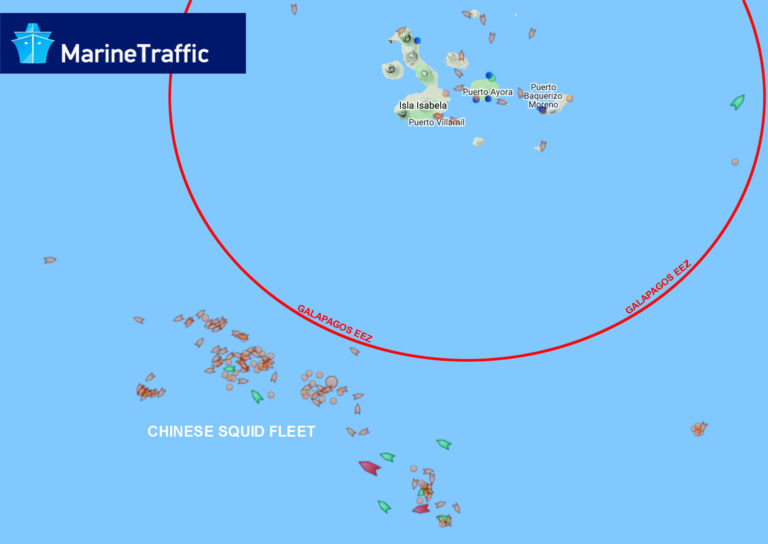
The Composition of the Fleet
The Chinese fleet operating near the Galapagos EEZ has familiar characteristics to mass fisheries elsewhere around the world. Huge fleets of industrial fishing vessels, ranging from 50-100 meters in length, are kept at sea for extended periods of time, and supported by the use of motherships, known as ‘reefers.’ These refrigerated cargo vessels, with huge freezer holds, rendezvous with fishing vessels and transship their catch, while at the same time they replenish the fishing vessels with food, water and crew before departing the area to take the catch back to onshore processing facilities. Many of the fishing vessels carry out primary onboard processing during the daylight hours, gutting and sorting squid for size, before packing and freezing them, in preparation for transshipment to the reefers.
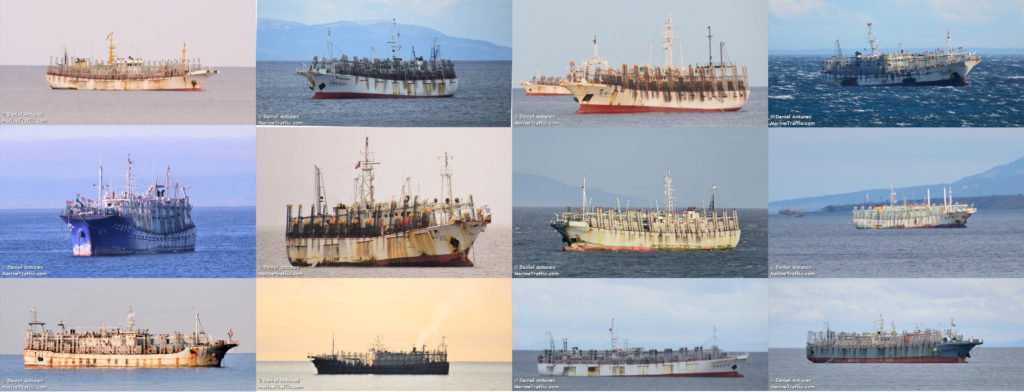
We monitored the fleet using commercial and publicly available vessel tracking software (Marine Traffic). We identified 213 individual fishing vessels and 17 reefers in this fleet from August 2 to 6, 2020. The reefers were Panamanian or Chinese flagged. We also identified four fuel tankers. The tankers that were in the fishing ground conducting suspected bunkering operations (refueling at sea) were the ‘Hai Gong You 303’ [Panama], ‘Bae Atahualpa’ [Ecuador], ‘Ocean Splendid’ [Panama] and ‘China Spirit’ [Liberia].
The combination of reefers, tankers and fishing vessels enable a fleet to continue fishing on the target fishing grounds indefinitely.
The utilization of “reefers” enables fishing fleets to stay at sea, relentlessly strip mining the ocean, accelerating the oceans and our very own demise!
Gary Stokes, Operation Director for OceansAsia
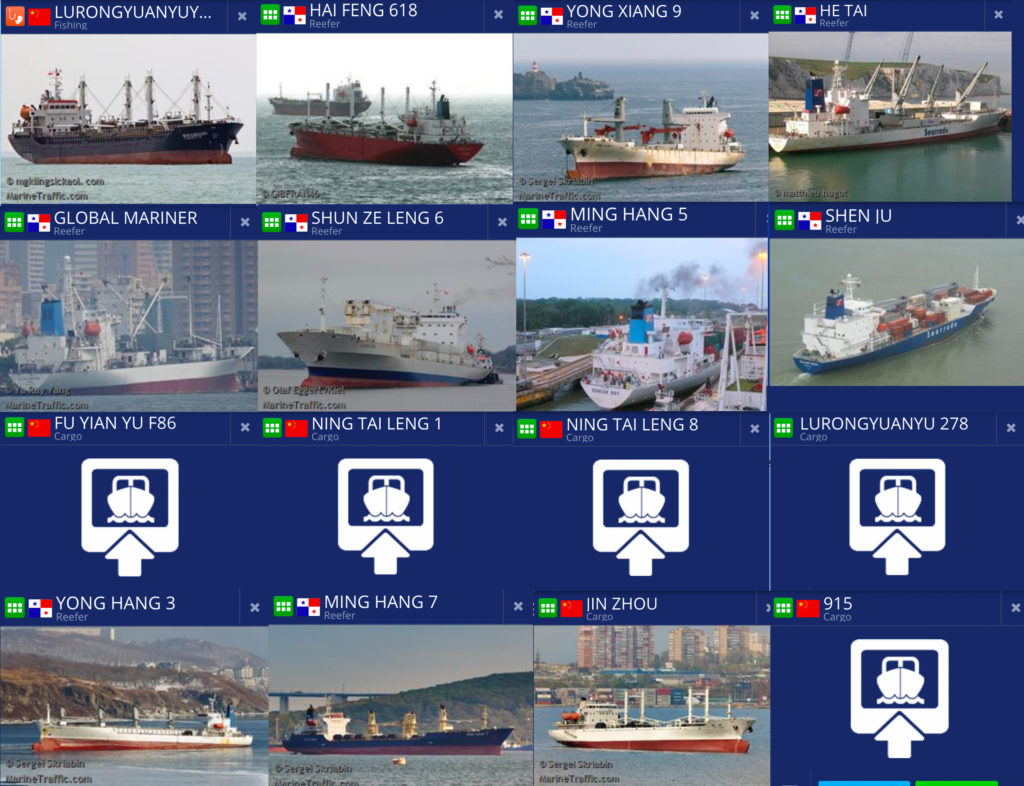
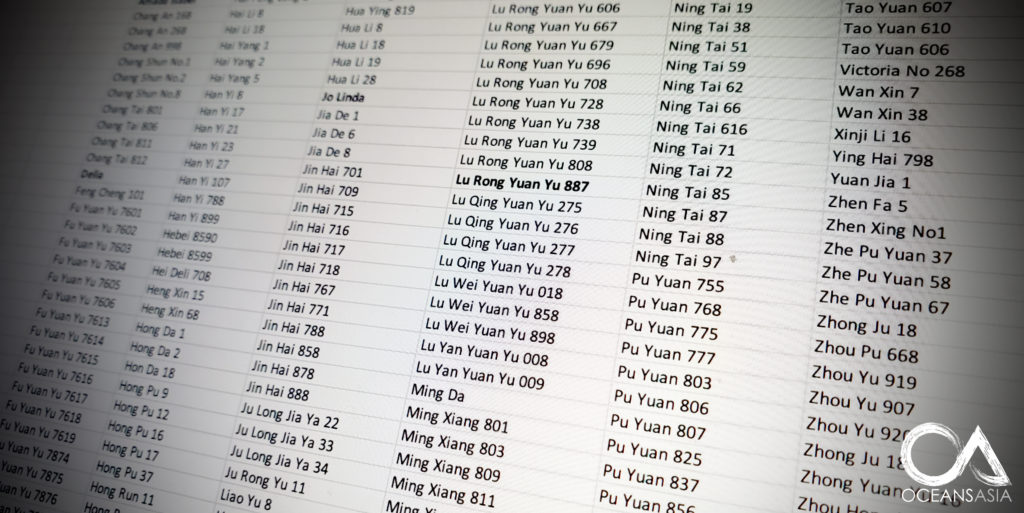
Squid Jiggers – How they work
The vessels are registered and fitted as ‘squid jiggers’ and claim to be engaged in a fishing method known as ‘squid jigging.’ This is a fishing method where fishers will use overhead lights to illuminate the water around a vessel in order to attract squid, which then gather in the shaded area below the vessel. Then, jigging machines are used to move barbless lures attached to monofilament fishing lines up and down. These lures are cylinders and covers in tiers of closely spaces spikes. When a squid tries to attack the jig, they get tangled up around the spikes. The machine then pulls the line up out of the water, recovering the lures and depositing the squid into the boat (source).
Due to the highly selective nature of squid jigging, there is normally no bycatch or interactions with protected species. Also, because the fishing gear does not come into contact with the bottom there is no damage to the sea floor or lost fishing gear (see for example source; source; source).
Demand
The world eats more than 3 million tons of squid per year, or at least one plate for each person.
United Nations Food and Agriculture Organization (FAO)
As the world population continues to grow, so does the demand for seafood and this is having a devastating effect on the worlds fish populations. The FAO has warned of a complete crash of global fisheries by 2048, and over a third of global fisheries are being fished a biologically unsustainable levels (source at p.7). Global fishing companies are very aware of this, seeing downturns in their catch of many of the ‘fin fish’. Sadly, it has now become a race to catch the last fish!
We are seeing a very frightening trend evolving as we over-fish one species, we casually move on to the next species as we ‘fish down the food web.” Fishers from many nations had little interest in squid until recent years, however this has changed as a result of the downturn in ‘fin fish’ catches.
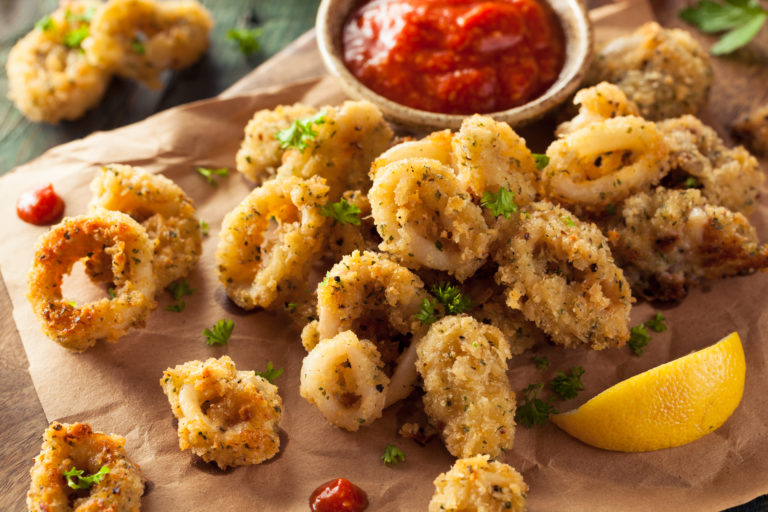
The Chinese fishing industry has recognized this problem and seems to have shifted a large percentage of its ‘Far Distant Fishing Fleet’ to squid (source; and see source at p.15). One third of China’s total catch landed from the sea comprises squid, and China catches approx 50-70% of global squid catch in international waters. This is a large and growing industry. According to the available research, the global squid market will be more than $11.6 billion USD by the end of year 2025. The squid caught by China’s ‘Far Distant Fishing Fleet’ is taken back to China where it is further processed and sold to both local markets in China and across the rest of Asia, along with a large percentage being exported to the USA, Europe and the rest of the world. For an example of the scale of this industry and the significant role played by China, one need only consider that in 2017, USA imported 80,300 tons of squid and cuttlefish, with 60% of this coming from China (source at p.31).
If you are eating calamari in your local restaurant, for example, there is a good chance it was caught by Chinese squid vessels operating somewhere in the world.
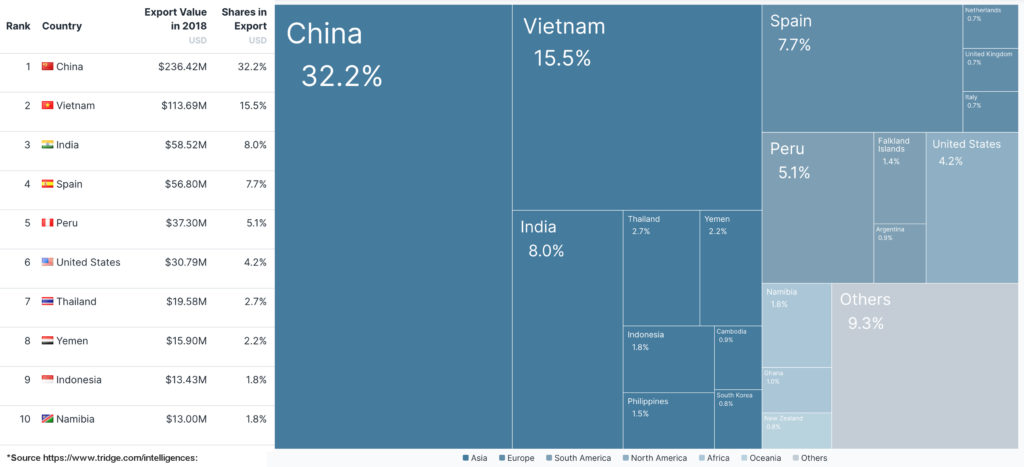
Conservation Measures
In June, China announced a voluntary moratorium on fishing in key high seas areas during squid spawning seasons to enable squid populations to replenish. All Chinese ocean-going fishing vessels operating in the designated high seas areas are required to abide by the fishing moratorium or face serious repercussions. Punishment for violating the moratorium could include fines, imprisonment and a loss of government subsidies, without which fishing operations would be impossible. Confiscation of vessels is also a possibility.
From July 1 to September 30, the moratorium includes squid spawning grounds in the high seas of the Southwest Atlantic Ocean (32°S – 44°S, 48°W – 60°W), and a similar spawning grounds in the high seas of the East Pacific Ocean between (5°N-5°S, 110°W-95°W) from September 1 to November 30 each year.
Each year China has a self-imposed moratorium along its coastal waters known as the “Summer Fishing Moratorium” which is strictly enforced. The squid moratorium is the first time they have enforced such measures moratorium on their ‘Far Distance Fishing Fleet’ operating in international waters. Any visit to a coastal port in China during this time would show thousands of coastal fishing vessels tied up in port.
The moratorium was adopted by the Chinese government and applies to Chinese-flagged vessels (and companies), the question is: what other countries will be fishing in these zones when the Chinese vessels are not?
While Chinese fishing capabilities are considerable, and this moratorium will certainly have some positive impact on squid spawning, it does raise the potential for a tragedy of the commons to emerge – for vessels from other countries to continue to fish in these areas during squid spawning season. Because these areas are on the high seas and in remote waters, the potential for both illegal fishing on the part of Chinese vessels, and continued fishing on the part of vessels from other nations is possible.
This potential underscores the importance of international cooperation in addressing conservation issues, something that is even more critical when addressing conservation issues on the high seas.
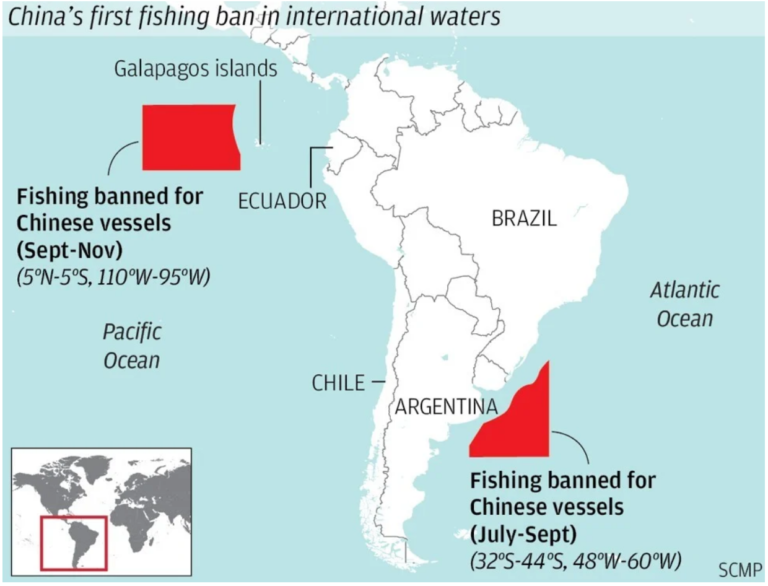
Geopolitics
Fishing operations and vessels have often been a catalyst for conflict between states. As China becomes more powerful in the global arena, its fishing operations have increasingly become a pawn in the ongoing great power cold war between the USA and China. Criticism of Chinese fishing operations are simply one element in this conflict. For example, the US Secretary of State/US State Department recently released a statement condemning the Chinese fleet.
We are not saying that China is innocent; far from it. However, it is important to focus on the facts: what is legal and what is not. China, like many nations, is aware of existence, scale, and impact of IUU fishing, and with the world’s largest fishing fleet they are a major contributor to IUU fishing. However, in evaluating individual cases, we must be careful stick with verifiable information. In this case, speculation and hyperbole appear to be driven in part by the ongoing China-US conflict.
There are valid concerns that can be raised with regards to large-scale industrial fishing, such as a lack of regulation on the high seas, the scale of global fishing fleets and state subsidies supporting fleets, the treatment of workers on vessels, or the impact of overfishing on marine ecosystems and wildlife populations. However, in this case the criticism appears disingenuous and part of a larger political agenda.
The current administration in the US has probably the worst track record when it comes to the environment, and has savaged previously established conservation laws. US Secretary of State, Michael Pompeo, does not care about sharks or the environment. He is using this current situation to fan the flames of anti-China sentiment, something that has been on the rise.
This kind of petty fear mongering, xenophobia and racism has no place in the conservation movement, and does nothing to address real and pressing conservation issues.
Dr Teale Phelps Bondaroff, Director of Research at OceansAsia
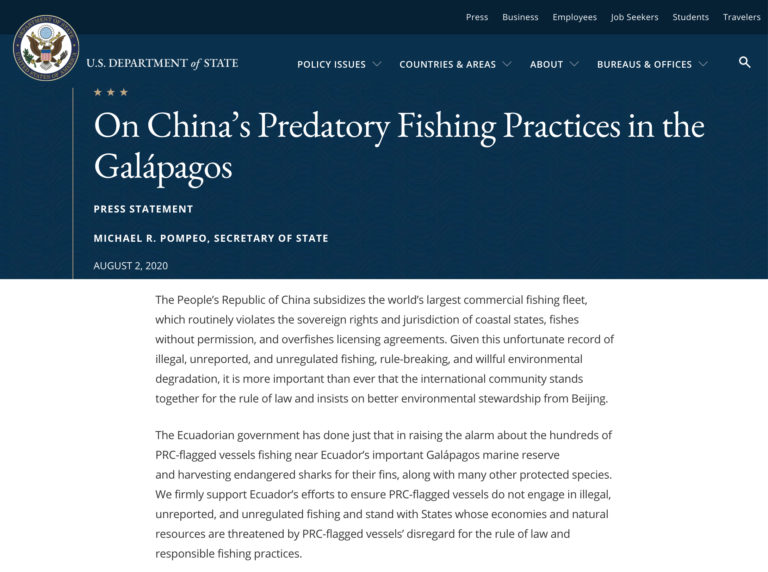
Conclusion
There is much to be done to protect our oceans. Large-scale industrial fishing is devastating ecosystems and marine wildlife populations. The solution, however, begins with accurate information. This is critical to both informing the development of sound conservation policy, but also to ensuring that the public is accurately informed. We must look beyond the headlines, and always be aware of how geopolitics and bias influence how stories are reported. Our oceans are being destroyed, and we need urgent action; action that includes such things as increased international and regional cooperation and management, the development of effectively monitored and enforced agreements, and the end to overfishing. We cannot do this without accurate information.
Furthermore, if you consume seafood, you have no right to condemn a Chinese fleet, or the fishing fleet of any nation that is legally catching the fish that you are consuming. If you want to stop the destruction of our oceans, stop eating seafood. No demand, means no fishing!
Lead image courtesy of Shutterstock.

